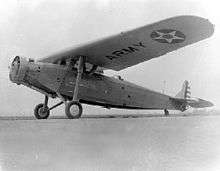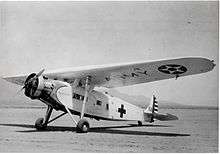Fokker F-14
The Fokker F-14 was an American seven/nine passenger transport aircraft designed by Fokker and built by their Atlantic Aircraft factory in New Jersey.
| Fokker F-14 | |
|---|---|
 | |
| Fokker C-14 | |
| Role | Seven/Nine passenger transport monoplane |
| Manufacturer | Atlantic Aircraft |
| First flight | 1929 |
| Primary user | United States Army Air Corps |
Development
The F-14 was a typical Fokker designed single-engine transport but unusually it had a parasol-type high wing carried on struts above the fuselage. It had a fixed tailwheel landing gear. The pilot had a cockpit behind the passenger cabin.
Variants
- F-14
- Civil production version with a 525 hp (391 kW) Wright R-1750-3 radial engine.
- F-14A
- Civilian aircraft with 575 hp (429 kW) Pratt & Whitney R-1690 Hornet radial and wing mounted directly on fuselage.

C-14
- Y1C-14
- Designation for 20 Hornet-powered examples bought for the United States Army Air Corps in 1931, later became the C-14.
- Y1C-14A
- Last of the 20 Y1C-14s re-engined with a 575 hp (429 kW) Wright R-1820-7 Cyclone.
- Y1C-14B
- Re-engined with a 525 hp (391 kW) Pratt & Whitney R-1690-5 Hornet.

The Y1C-15
- Y1C-15
- Conversion of the ninth Y1C-14 as an air ambulance.[1]
- Y1C-15A
- F-14 re-engined with a 575 hp (429 kW) Wright R-1820 Cyclone, later C-15A.
Operators
- MacKenzie Air Services
- Western Canada Airways
- Standard Air Lines
- Transcontinental & Western Air
- United States Army Air Corps
Specifications (F-14)
Data from The Illustrated Encyclopedia of Aircraft (Part Work 1982-1985), 1985, Orbis Publishing, Page 1878
General characteristics
- Crew: 1
- Capacity: seven/nine passengers
- Length: 43 ft 3 in (13.18 m)
- Wingspan: 59 ft 5 in (18.11 m)
- Height: 12 ft 4 in (3.76 m)
- Wing area: 551 sq ft (51.19 m2)
- Empty weight: 4,346 lb (1,971 kg)
- Gross weight: 7,200 lb (3,266 kg)
- Powerplant: 1 × Wright R-1750-3 9-cylinder radial , 525 hp (391 kW)
Performance
- Maximum speed: 137 mph (220 km/h, 119 kn)
- Range: 690 mi (1,100 km, 600 nmi)
- Service ceiling: 14,500 ft (4,420 m)
Related lists
gollark: They have consoles.
gollark: Actually, there is a point: some weirdos might like vendor lock-in.
gollark: XbOx livE does sound quite pointless. I think that Steam already goes a bit too far in trying to gamify buying games and having friend stuff.
gollark: I mostly play Factorio now, but Minecraft (Java Edition, with mods) has very nice, varied, user-selectable gameplay.
gollark: ^
References
- John Andrade, U.S.Military Aircraft Designations and Serials since 1909, Midland Counties Publications, 1979, ISBN 0-904597-22-9 (Page 62)
- The Illustrated Encyclopedia of Aircraft (Part Work 1982-1985), 1985, Orbis Publishing, Page 1878.
External links
| Wikimedia Commons has media related to Fokker C-14. |
- "Mercy Flyers Bring" rare photos of USAAC ambulance version page 20 (top) and page 21 (bottom)
- "Ambulance Plan `Chute Designed For Patients" June 1934 Popular Science Monthly - Y1C-15 used for testing of emergency parachute for stretcher patients
This article is issued from Wikipedia. The text is licensed under Creative Commons - Attribution - Sharealike. Additional terms may apply for the media files.